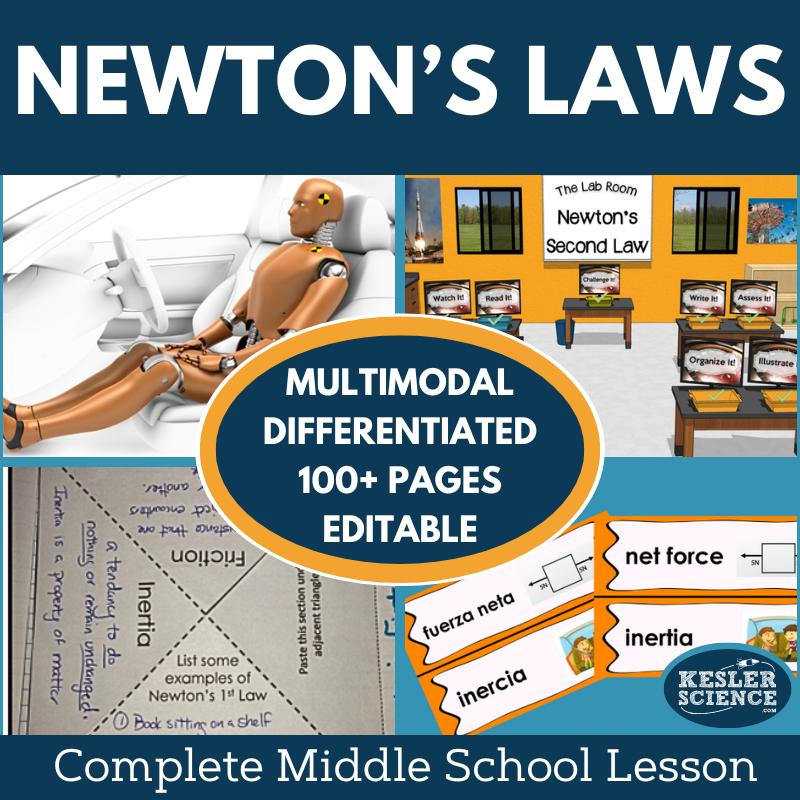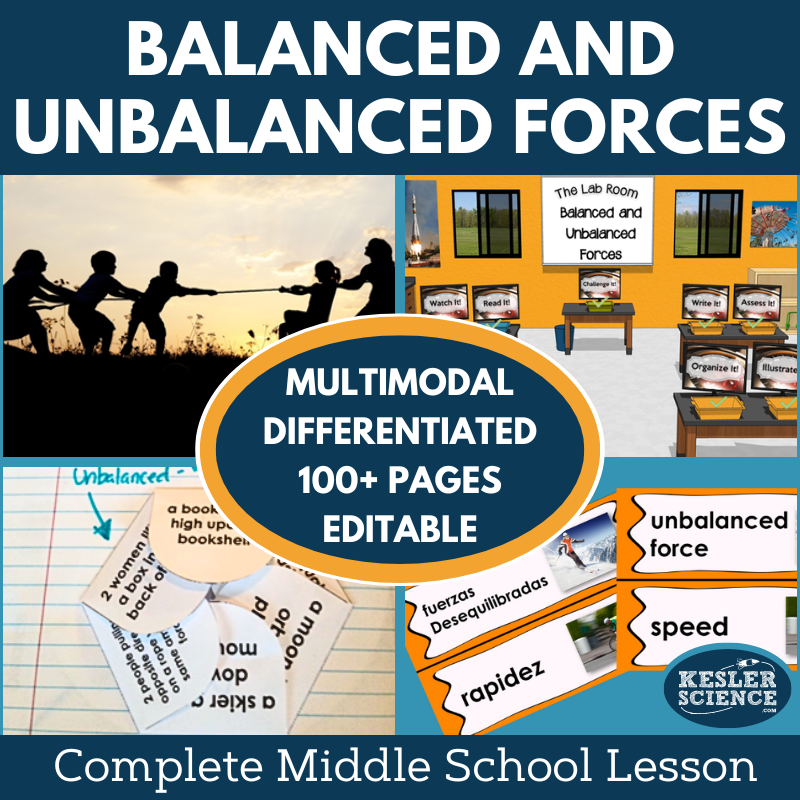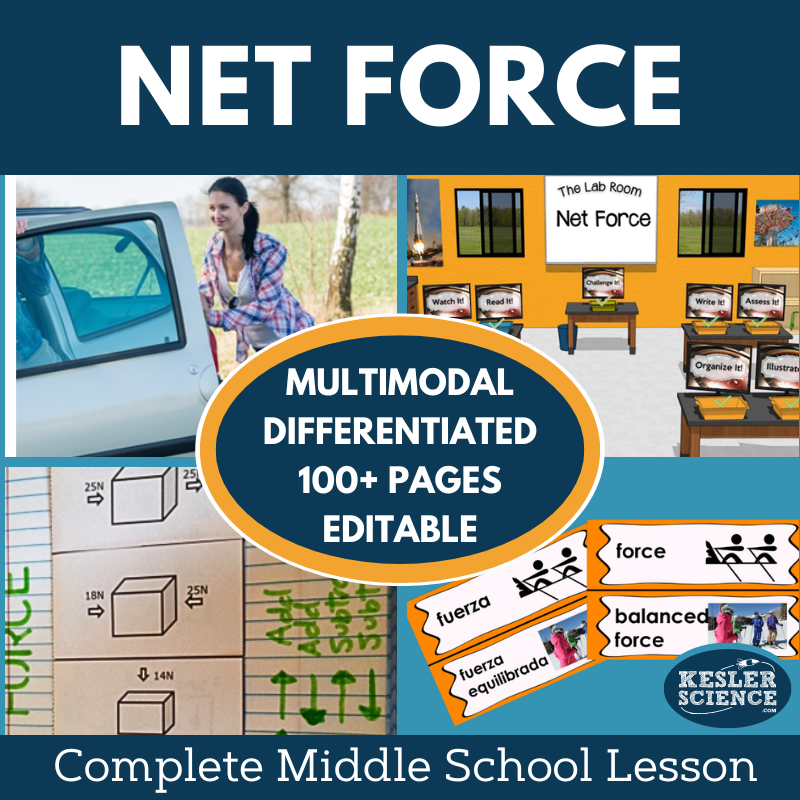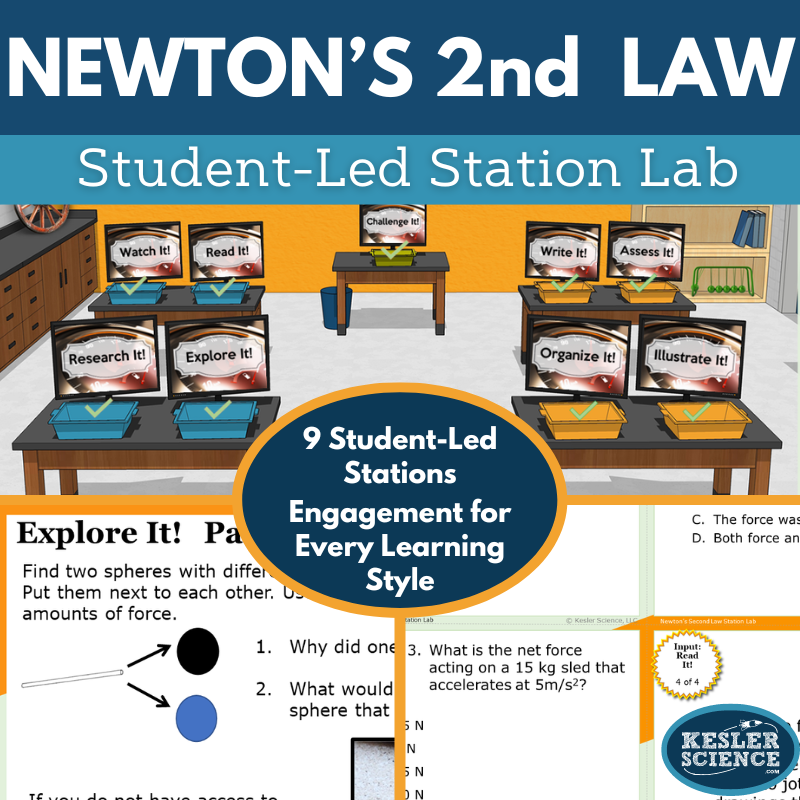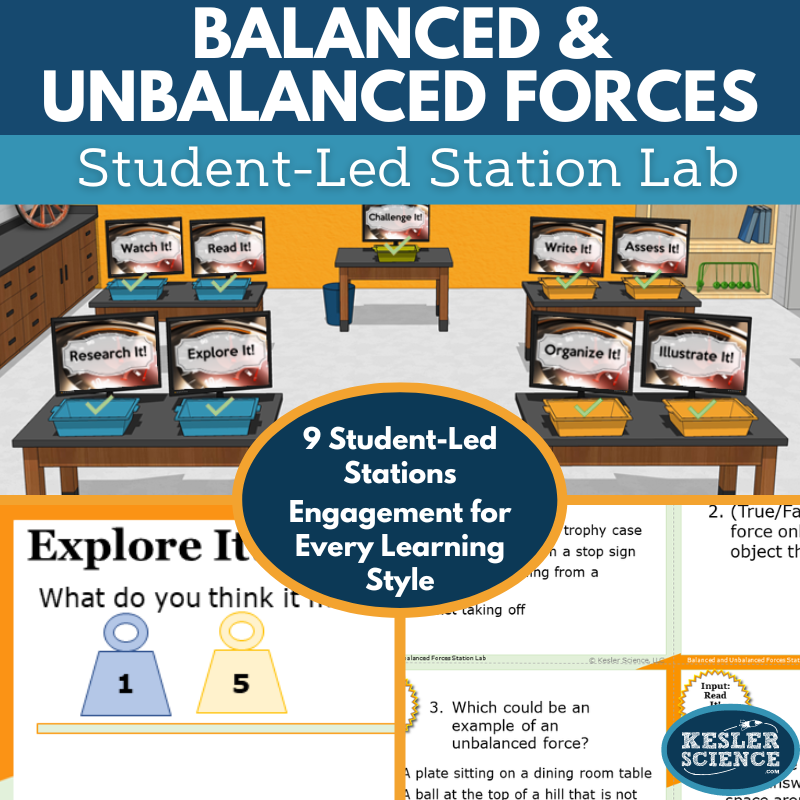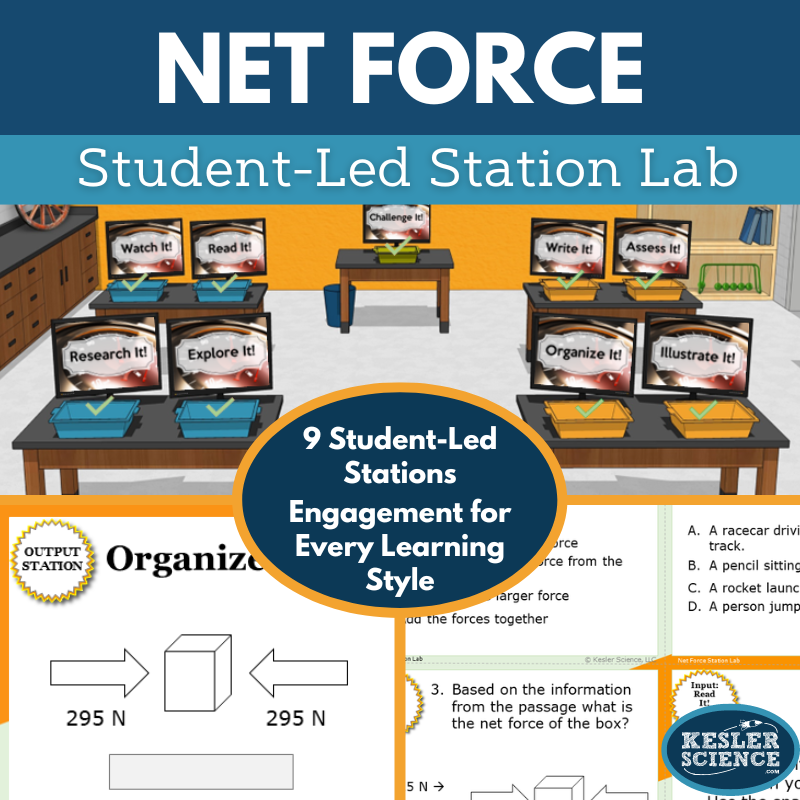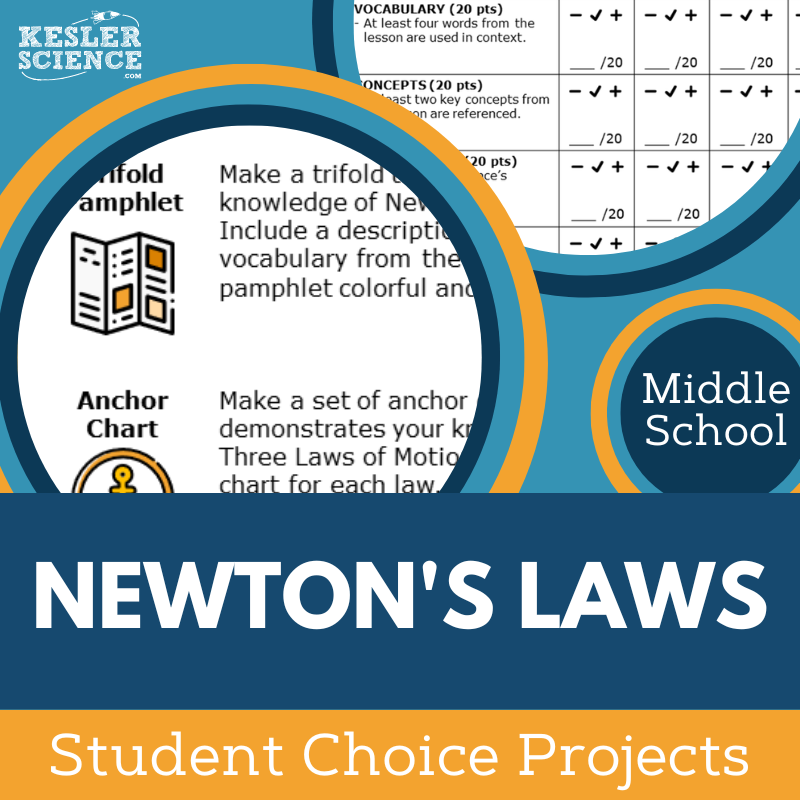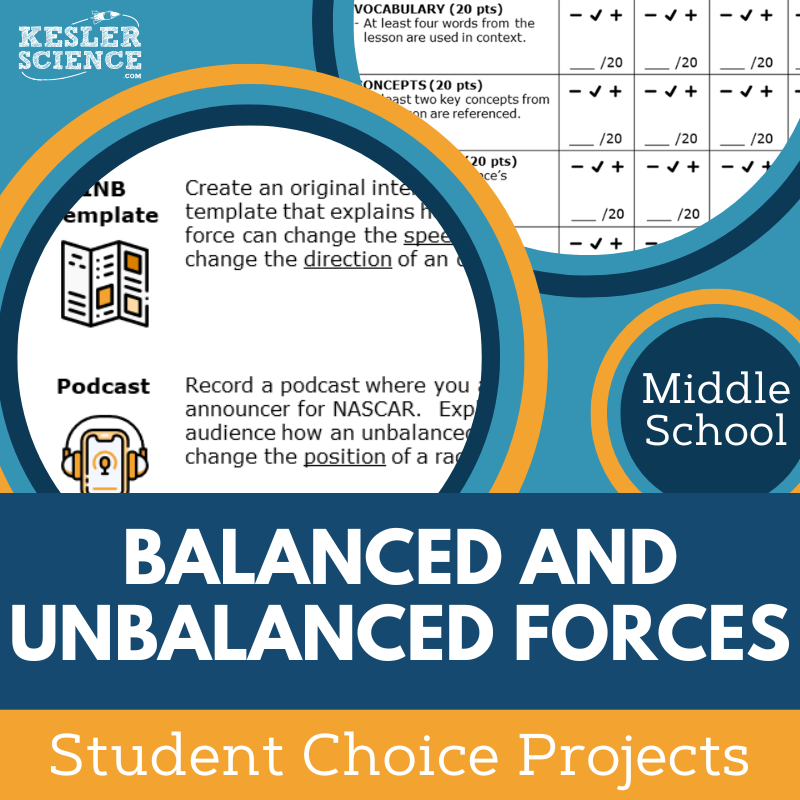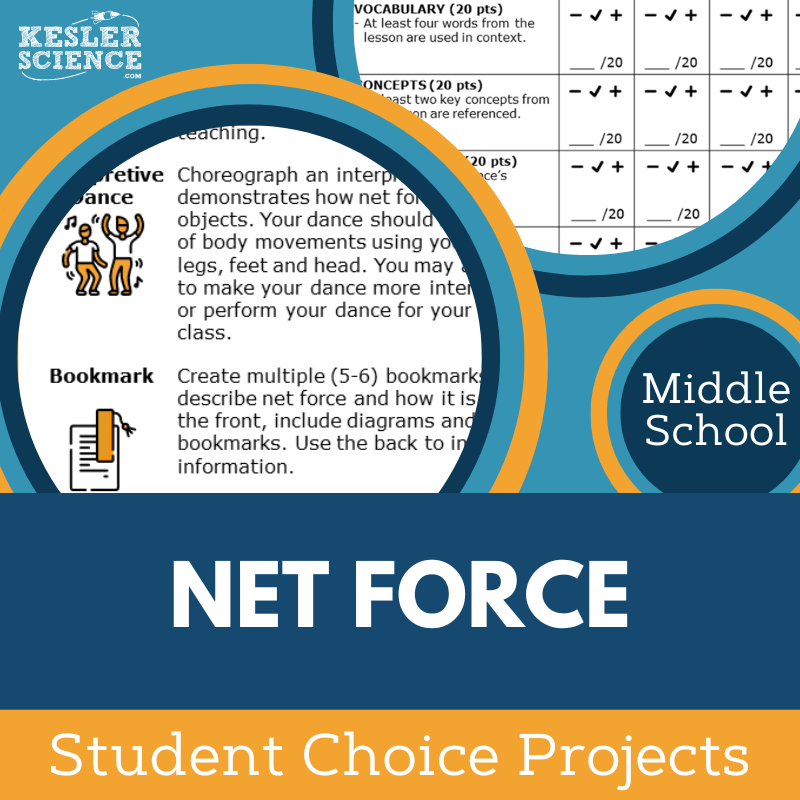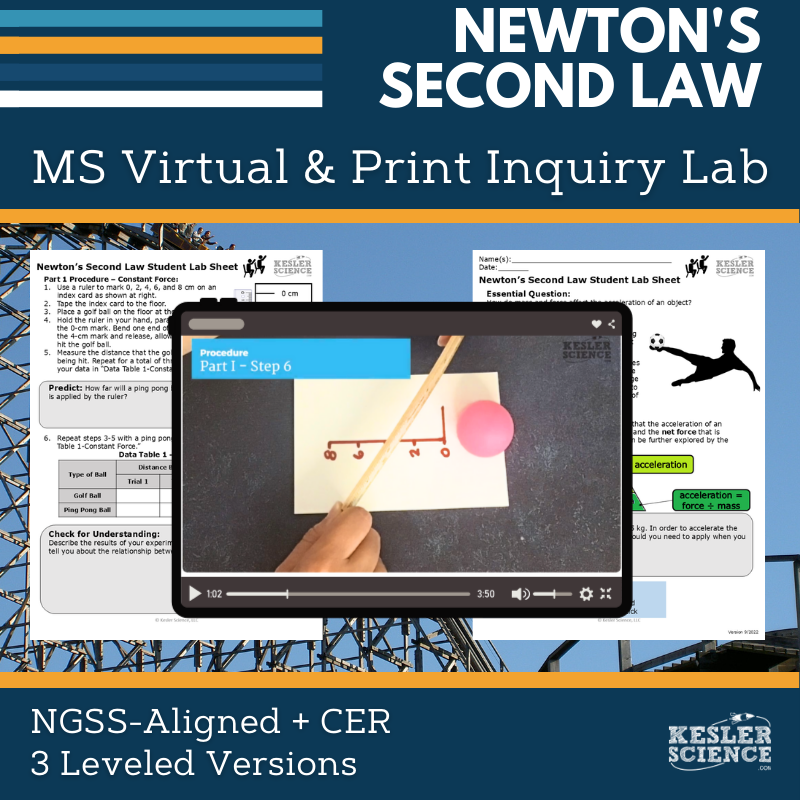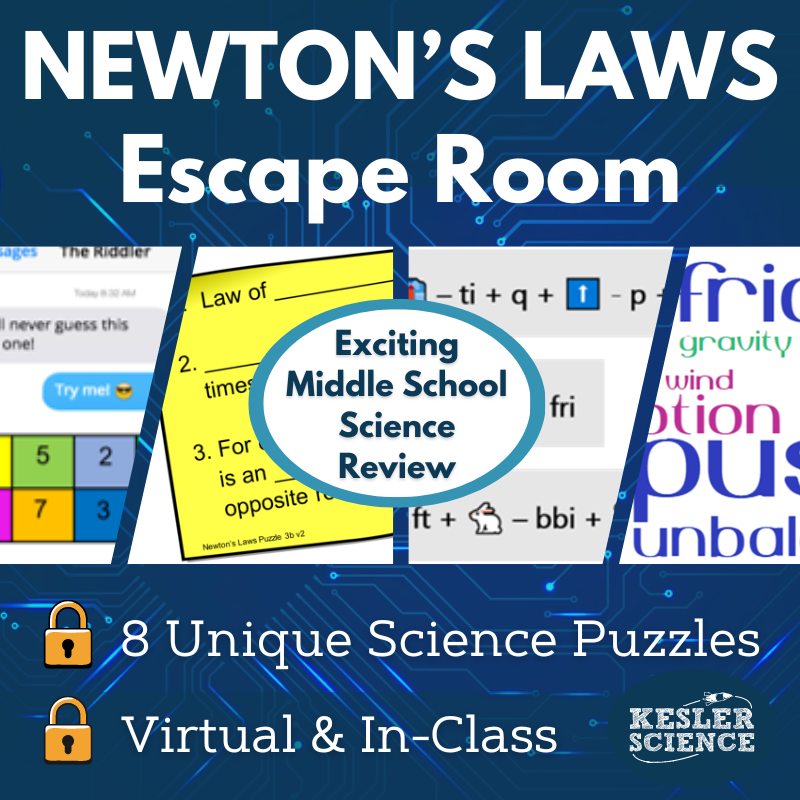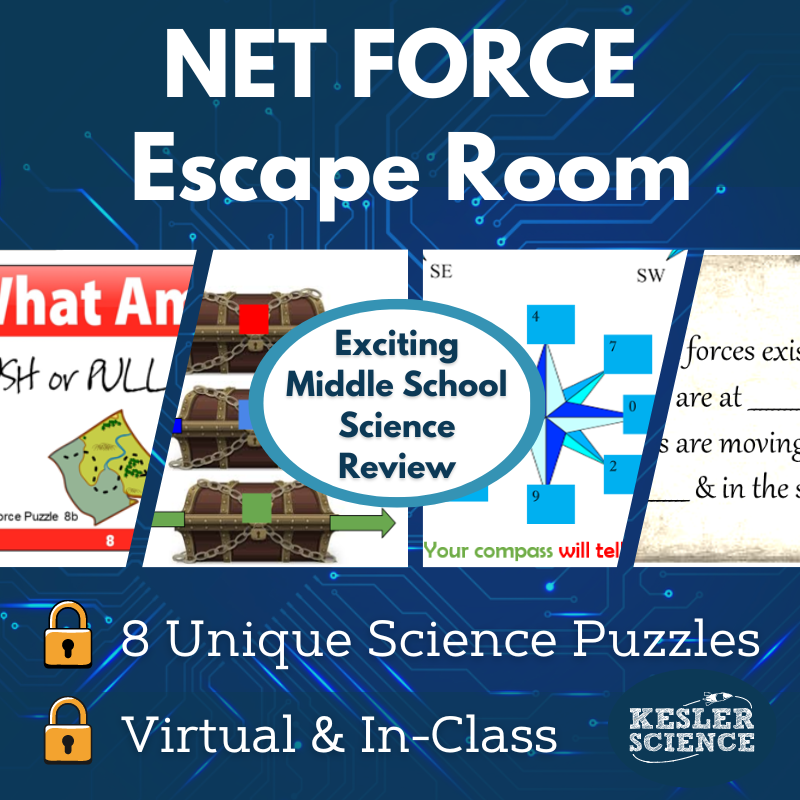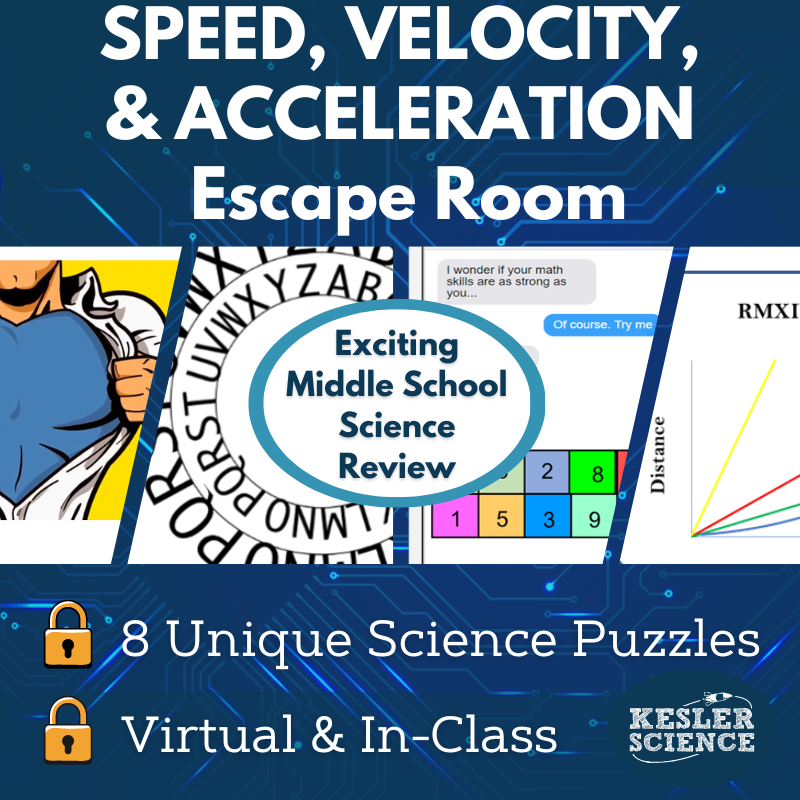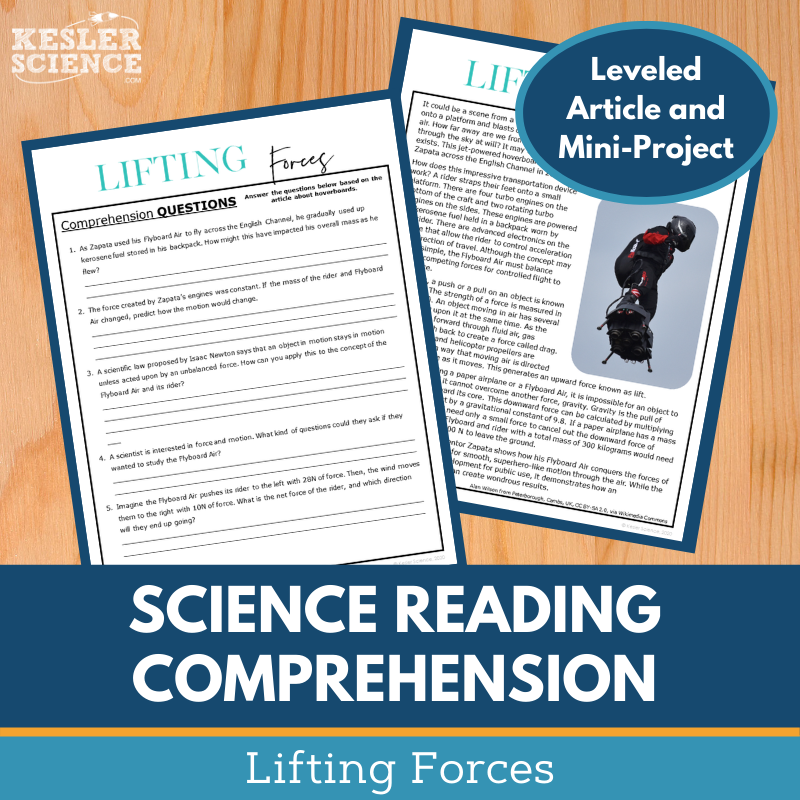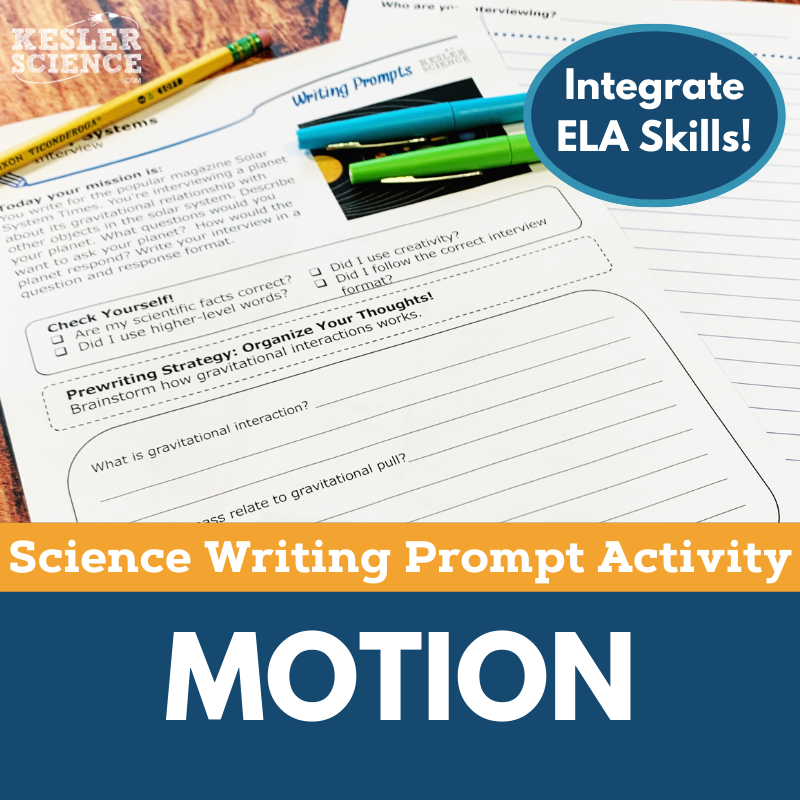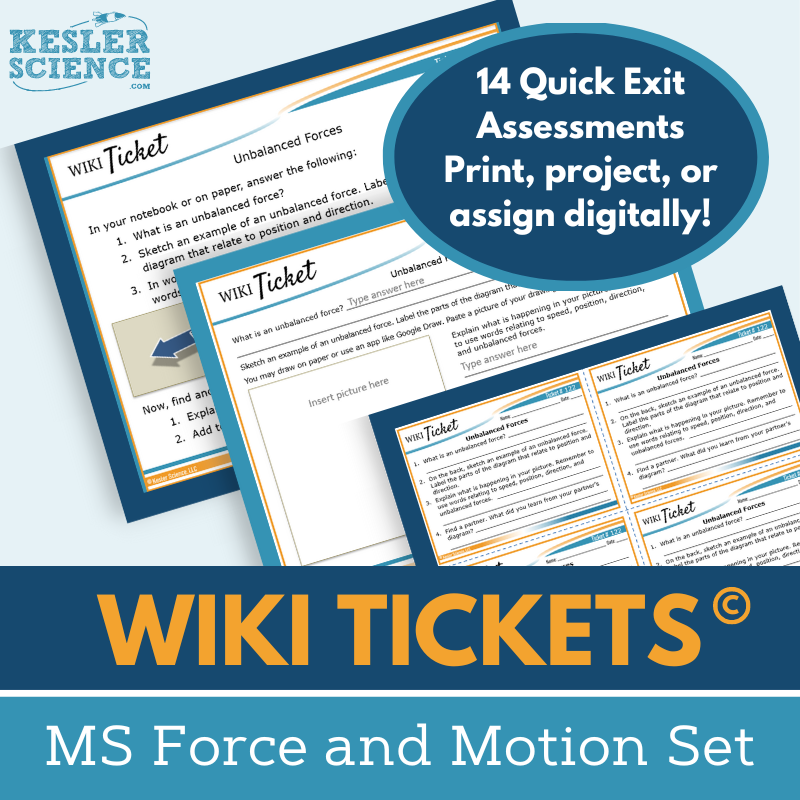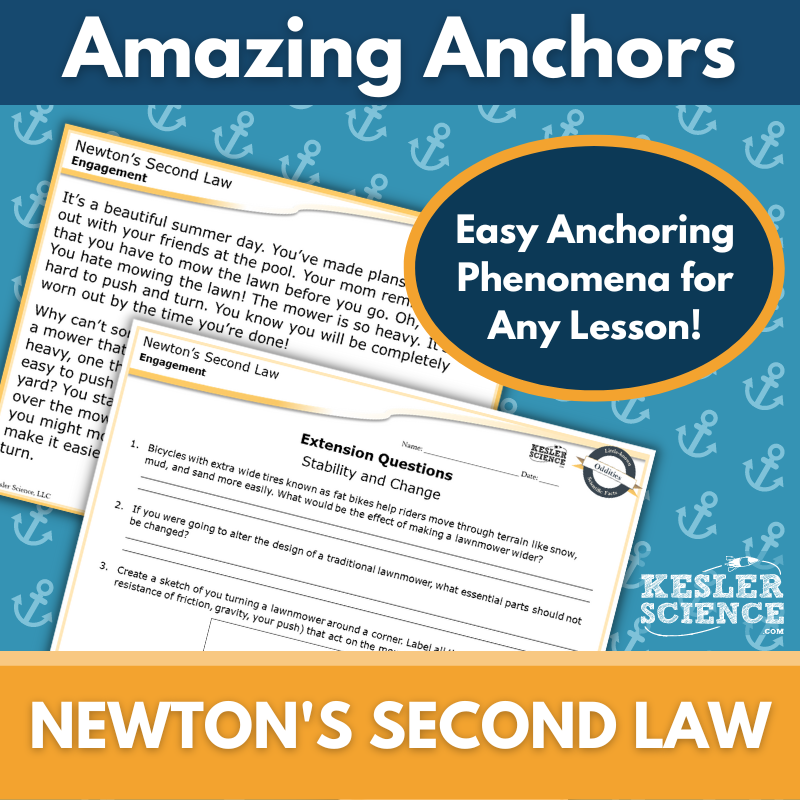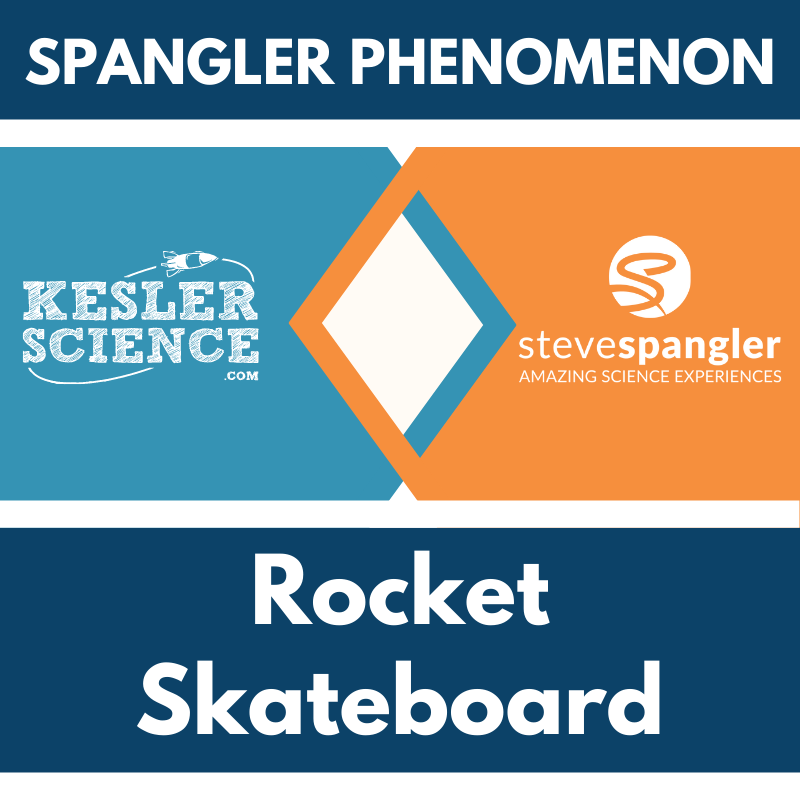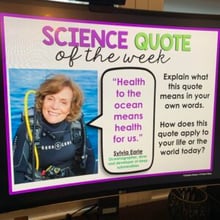Changes in an Object's Motion Activities for Middle School Science
The Kesler Science Newton’s Laws, Balanced and Unbalanced Forces, and Net Force 5E Lessons provide engaging, student-led experiences for middle school learners, requiring minimal prep while supporting differentiated instruction. The resources below will give students a comprehensive understanding of Newton's first and second laws. All of the following materials are also included in the Kesler Science Membership.
The Kesler Science Newton’s Laws 5E Lesson is a comprehensive, student-led unit designed for middle school learners. It includes editable presentations, worksheets, choice projects, and assessments, requiring minimal prep while supporting differentiated instruction. The lesson engages students with essential questions about Newton’s laws and their real-world applications in sports, amusement parks, tectonic forces, and rocket launches.
Following the 5E Model, the lesson features engagement activities, a hands-on, differentiated exploration station lab with nine stations, and editable PowerPoints in both standard and interactive formats. Students can explore concepts through reading passages, experiments, videos, and research tasks, while output stations reinforce learning through writing, drawing, categorization, and assessment. Spanish translations are available for vocabulary, reading passages, and interactive notebooks.
Students extend their learning through choice projects and are assessed with STAAR 2.0-aligned questions, review worksheets, and modified evaluation options. The materials are adaptable for both in-class and virtual learning environments, ensuring flexibility and accessibility.
The Kesler Science Newton’s Laws 5E Lesson is a comprehensive, student-led unit designed for middle school learners. It includes editable presentations, worksheets, choice projects, and assessments, requiring minimal prep while supporting differentiated instruction. The lesson engages students with essential questions about Newton’s Laws and their real-world applications in sports, amusement parks, tectonic forces, and rocket launches.
Following the 5E Model, the lesson features engagement activities, a hands-on, differentiated exploration station lab with nine stations, and editable PowerPoints in both standard and interactive formats. Students can explore concepts through reading passages, experiments, videos, and research tasks, while output stations reinforce learning through writing, drawing, categorization, and assessment. Spanish translations are available for vocabulary, reading passages, and interactive notebooks.
Students extend their learning through choice projects and are assessed with STAAR 2.0-aligned questions, review worksheets, and modified evaluation options. The materials are adaptable for both in-class and virtual learning environments, ensuring flexibility and accessibility.
The Kesler Science Balanced and Unbalanced Forces Complete Lesson is an engaging, student-led unit designed for middle school classrooms. It includes editable presentations, worksheets, choice projects, and assessments, all requiring minimal prep. Aligned with NGSS and TEKS, the lesson supports differentiated learning and multimodal engagement.
The unit follows the 5E Model, providing structured resources for each phase. In the Engagement phase, students explore key vocabulary with word wall cards and class discussions. The Exploration phase features a differentiated, student-led station lab with nine stations, including hands-on demos, reading passages in English and Spanish, research tasks, and video discussions. Output stations allow students to demonstrate understanding through sorting activities, writing responses, illustrations, and assessments.
Explanation materials include editable PowerPoints, interactive notebooks, and note-taking templates in digital and print formats. The Elaboration phase offers student-choice projects to extend learning, while Evaluation includes STAAR 2.0-aligned assessments, review questions, and worksheets. Designed for flexibility, the lesson is available in both printable and digital formats, making it ideal for in-person and virtual learning environments.
The Kesler Science Balanced and Unbalanced Forces Complete Lesson is an engaging, student-led unit designed for middle school classrooms. It includes editable presentations, worksheets, choice projects, and assessments, all requiring minimal prep. Aligned with NGSS and TEKS, the lesson supports differentiated learning and multimodal engagement.
The unit follows the 5E Model, providing structured resources for each phase. In the Engagement phase, students explore key vocabulary with word wall cards and class discussions. The Exploration phase features a differentiated, student-led station lab with nine stations, including hands-on demos, reading passages in English and Spanish, research tasks, and video discussions. Output stations allow students to demonstrate understanding through sorting activities, writing responses, illustrations, and assessments.
Explanation materials include editable PowerPoints, interactive notebooks, and note-taking templates in digital and print formats. The Elaboration phase offers student-choice projects to extend learning, while Evaluation includes STAAR 2.0-aligned assessments, review questions, and worksheets. Designed for flexibility, the lesson is available in both printable and digital formats, making it ideal for in-person and virtual learning environments.
The Kesler Science Net Force 5E Lesson is a comprehensive, student-led unit designed for middle school. It includes editable presentations, worksheets, assessments, and choice projects, requiring minimal prep while allowing for differentiated learning.
Using the 5E Model, the lesson engages students with objectives, word wall cards, and discussion activities. Exploration includes a differentiated station lab with nine stations that incorporate hands-on experiments, reading passages in English and Spanish, research tasks, videos, and interactive activities. Explanation features editable PowerPoints, interactive notebooks, and note-taking templates. Elaboration allows students to extend their learning through choice projects, while Evaluation includes STAAR 2.0-aligned assessments, review questions, and worksheets.
Designed for both in-person and virtual learning, the lesson offers flexible formats, including digital and printable options. Spanish translations are available for vocabulary, reading passages, and interactive notebook pages. With multimodal learning and differentiated materials, this unit keeps students engaged while reinforcing key concepts in net force.
The Kesler Science Net Force 5E Lesson is a comprehensive, student-led unit designed for middle school. It includes editable presentations, worksheets, assessments, and choice projects, requiring minimal prep while allowing for differentiated learning.
Using the 5E Model, the lesson engages students with objectives, word wall cards, and discussion activities. Exploration includes a differentiated station lab with nine stations that incorporate hands-on experiments, reading passages in English and Spanish, research tasks, videos, and interactive activities. Explanation features editable PowerPoints, interactive notebooks, and note-taking templates. Elaboration allows students to extend their learning through choice projects, while Evaluation includes STAAR 2.0-aligned assessments, review questions, and worksheets.
Designed for both in-person and virtual learning, the lesson offers flexible formats, including digital and printable options. Spanish translations are available for vocabulary, reading passages, and interactive notebook pages. With multimodal learning and differentiated materials, this unit keeps students engaged while reinforcing key concepts in net force.
Engage your middle school students with this student-led station lab on Newton’s laws, designed to encourage independent learning and critical thinking. This hands-on activity guides students in planning an investigation to understand how an object’s motion changes based on the sum of forces and mass.
Students explore Newton’s laws through nine interactive stations that incorporate reading, research, videos, and hands-on demonstrations. Input stations introduce concepts through exploration, online research, reading passages (available in English and Spanish), and video analysis. Output stations allow students to demonstrate understanding by organizing information, illustrating models, writing responses, and completing assessments. A bonus challenge station offers extension activities for early finishers.
With differentiated tasks and a modular structure, this resource supports personalized learning in both in-person and virtual environments. Low-prep and highly engaging, this station lab fosters student-centered discovery and deeper comprehension of force and motion concepts.
Engage your middle school students with this student-led station lab on Newton’s laws, designed to encourage independent learning and critical thinking. This hands-on activity guides students in planning an investigation to understand how an object’s motion changes based on the sum of forces and mass.
Students explore Newton’s laws through nine interactive stations that incorporate reading, research, videos, and hands-on demonstrations. Input stations introduce concepts through exploration, online research, reading passages (available in English and Spanish), and video analysis. Output stations allow students to demonstrate understanding by organizing information, illustrating models, writing responses, and completing assessments. A bonus challenge station offers extension activities for early finishers.
With differentiated tasks and a modular structure, this resource supports personalized learning in both in-person and virtual environments. Low-prep and highly engaging, this station lab fosters student-centered discovery and deeper comprehension of force and motion concepts.
Engage your middle school students with this student-led station lab on balanced and unbalanced forces. This interactive lesson allows students to explore changes in an object's position, direction, and speed when acted upon by an unbalanced force through a variety of differentiated activities.
Students direct their own learning through nine modular stations, featuring hands-on demonstrations, research tasks, reading passages, videos, and interactive exercises. They demonstrate understanding by organizing information, illustrating models, writing responses, and completing assessments. A challenge station provides extension activities for early finishers.
Designed for flexible learning, this resource includes all necessary materials for independent or small-group work, with virtual adaptations for digital platforms like PowerPoint and Google Slides. This low-prep, high-engagement activity fosters critical thinking and deepens understanding of force and motion concepts.
Engage your middle school students with this student-led station lab on balanced and unbalanced forces. This interactive lesson allows students to explore changes in an object's position, direction, and speed when acted upon by an unbalanced force through a variety of differentiated activities.
Students direct their own learning through nine modular stations, featuring hands-on demonstrations, research tasks, reading passages, videos, and interactive exercises. They demonstrate understanding by organizing information, illustrating models, writing responses, and completing assessments. A challenge station provides extension activities for early finishers.
Designed for flexible learning, this resource includes all necessary materials for independent or small-group work, with virtual adaptations for digital platforms like PowerPoint and Google Slides. This low-prep, high-engagement activity fosters critical thinking and deepens understanding of force and motion concepts.
Engage your middle school students with this student-led net force station lab, designed to promote hands-on learning and critical thinking. This low-prep resource allows students to explore force and motion through nine interactive stations, offering differentiated activities that cater to various learning styles. Students take charge of their learning as they apply net forces to real-world scenarios.
Students encounter net force concepts through hands-on demonstrations, research, readings, and videos, then demonstrate their understanding by organizing information, illustrating models, writing responses, and completing assessments. A challenge station provides extension activities for advanced learners, and English and Spanish reading passages support differentiated instruction. Stations can be completed independently or in small groups, fostering collaboration and problem-solving skills.
Ideal for both in-class and virtual learning, this modular lab encourages inquiry-based exploration while reinforcing key science concepts in an engaging and meaningful way.
Engage your middle school students with this student-led net force station lab, designed to promote hands-on learning and critical thinking. This low-prep resource allows students to explore force and motion through nine interactive stations, offering differentiated activities that cater to various learning styles. Students take charge of their learning as they apply net forces to real-world scenarios.
Students encounter net force concepts through hands-on demonstrations, research, readings, and videos, then demonstrate their understanding by organizing information, illustrating models, writing responses, and completing assessments. A challenge station provides extension activities for advanced learners, and English and Spanish reading passages support differentiated instruction. Stations can be completed independently or in small groups, fostering collaboration and problem-solving skills.
Ideal for both in-class and virtual learning, this modular lab encourages inquiry-based exploration while reinforcing key science concepts in an engaging and meaningful way.
The Newton’s Laws Student Choice Projects align with NGSS science standards, allowing middle school students to select a project that suits their preferred output style. A project page outlines six structured student-led options and a “design your own” project, with an editable rubric for teacher, peer, or self-assessment.
These projects are flexible and adaptable, offering multimodal choices for students to demonstrate their understanding creatively. Teachers can modify the rubric to fit grading needs. Two versions of the project page support differentiation, with targeted options for students needing remediation and opportunities for advanced learners to take on more challenging tasks.
The projects require standard classroom supplies such as paper, markers, and scissors, with many options available for digital completion. Some crafting materials may be useful for building models.
The Newton’s Laws Student Choice Projects align with NGSS science standards, allowing middle school students to select a project that suits their preferred output style. A project page outlines six structured student-led options and a “design your own” project, with an editable rubric for teacher, peer, or self-assessment.
These projects are flexible and adaptable, offering multimodal choices for students to demonstrate their understanding creatively. Teachers can modify the rubric to fit grading needs. Two versions of the project page support differentiation, with targeted options for students needing remediation and opportunities for advanced learners to take on more challenging tasks.
The projects require standard classroom supplies such as paper, markers, and scissors, with many options available for digital completion. Some crafting materials may be useful for building models.
The Balanced and Unbalanced Forces Student Choice Projects lesson allows middle school students to select a project that aligns with their preferred output style. A project page outlines six student-led options, plus a “design your own” project, all with an editable rubric for teacher, peer, or self-assessment.
These flexible, multimodal projects provide creative ways for students to demonstrate their understanding. Teachers can modify the rubric to fit grading needs, and two versions of the project page support differentiation. The modified version includes three options designed for students needing remediation, while advanced learners can take on multiple projects using the same rubric.
The projects require standard classroom supplies like paper, markers, and scissors, with many options available for digital completion. Some crafting materials may be useful for model-building.
The Balanced and Unbalanced Forces Student Choice Projects lesson allows middle school students to select a project that aligns with their preferred output style. A project page outlines six student-led options, plus a “design your own” project, all with an editable rubric for teacher, peer, or self-assessment.
These flexible, multimodal projects provide creative ways for students to demonstrate their understanding. Teachers can modify the rubric to fit grading needs, and two versions of the project page support differentiation. The modified version includes three options designed for students needing remediation, while advanced learners can take on multiple projects using the same rubric.
The projects require standard classroom supplies like paper, markers, and scissors, with many options available for digital completion. Some crafting materials may be useful for model-building.
The Net Force Student Choice Projects lesson aligns with NGSS science standards, allowing middle school students to choose from six project options or design their own. A project page provides guidance, and an editable rubric supports teacher, peer, or self-assessment.
These flexible, multimodal projects offer creative ways for students to demonstrate their understanding. Teachers can modify the rubric to fit grading needs, and two versions of the project page support differentiation, with modified options for students needing remediation and challenge opportunities for advanced learners.
Projects use standard classroom supplies like paper, markers, and scissors, with many options available for digital completion. Some crafting supplies may be helpful for model-building.
The Net Force Student Choice Projects lesson aligns with NGSS science standards, allowing middle school students to choose from six project options or design their own. A project page provides guidance, and an editable rubric supports teacher, peer, or self-assessment.
These flexible, multimodal projects offer creative ways for students to demonstrate their understanding. Teachers can modify the rubric to fit grading needs, and two versions of the project page support differentiation, with modified options for students needing remediation and challenge opportunities for advanced learners.
Projects use standard classroom supplies like paper, markers, and scissors, with many options available for digital completion. Some crafting supplies may be helpful for model-building.
The Newton's Second Law Inquiry Lab aligns with NGSS MS-PS2-2, helping students investigate how force and mass affect an object's acceleration. Students will apply varying amounts of force to a golf ball and measure its travel distance, as well as compare the effects of equal force on a golf ball and a ping pong ball.
This lab is available in both print and digital formats. The print version provides a hands-on experiment where students record their observations, while the digital version includes an interactive PowerPoint with a pre-recorded video demonstrating the lab procedure. Both formats incorporate comprehension questions, Claim-Evidence-Reasoning (C.E.R.) prompts, and reflection sections.
Three differentiated levels—dependent, modified, and independent—allow for flexible instruction. The dependent version provides structured inquiry, the modified version includes scaffolding with sentence stems and multiple-choice options, and the independent version encourages student-led exploration.
Editable teacher resources include answer keys, standards, objectives, prep time, and instructional materials. The digital format is compatible with Google Slides and various LMS platforms, offering a multimodal learning experience for middle school students.
The Newton's Second Law Inquiry Lab aligns with NGSS MS-PS2-2, helping students investigate how force and mass affect an object's acceleration. Students will apply varying amounts of force to a golf ball and measure its travel distance, as well as compare the effects of equal force on a golf ball and a ping pong ball.
This lab is available in both print and digital formats. The print version provides a hands-on experiment where students record their observations, while the digital version includes an interactive PowerPoint with a pre-recorded video demonstrating the lab procedure. Both formats incorporate comprehension questions, Claim-Evidence-Reasoning (C.E.R.) prompts, and reflection sections.
Three differentiated levels—dependent, modified, and independent—allow for flexible instruction. The dependent version provides structured inquiry, the modified version includes scaffolding with sentence stems and multiple-choice options, and the independent version encourages student-led exploration.
Editable teacher resources include answer keys, standards, objectives, prep time, and instructional materials. The digital format is compatible with Google Slides and various LMS platforms, offering a multimodal learning experience for middle school students.
The Newton’s Laws Escape Room is an interactive experience that engages students in demonstrating their understanding of Newton’s three laws through real-world applications. Before participating, students should be familiar with key vocabulary, including inertia, force, mass, acceleration, and friction. This activity aligns with NGSS MS-PS2-1 and MS-PS2-2.
Unlike traditional escape rooms, teachers can customize the experience by selecting from eight independent puzzles, making it adaptable to various class periods. The activity can be conducted using simple materials like manila envelopes or a more immersive setup with locks, hasps, and storage boxes. Printable materials and supply links are provided for flexibility.
For digital learning, a Single Student Digital Version is available as a PowerPoint file, which can be assigned via email or a learning management system. This version can also be uploaded to Google Drive and used with Google Slides. A printable version is offered as a PPT or PDF for at-home use, with copyright restrictions limiting sharing to individual classrooms.
Included in this resource are teacher directions, a detailed answer key, digital answer sheets for Google Classroom, a video challenge, eight unique puzzles with printable props, and over 50 prize ideas. Additional resources include reward templates and editable signs for post-game photos. This engaging escape room will leave students excited and eager to apply their knowledge.
The Newton’s Laws Escape Room is an interactive experience that engages students in demonstrating their understanding of Newton’s three laws through real-world applications. Before participating, students should be familiar with key vocabulary, including inertia, force, mass, acceleration, and friction. This activity aligns with NGSS MS-PS2-1 and MS-PS2-2.
Unlike traditional escape rooms, teachers can customize the experience by selecting from eight independent puzzles, making it adaptable to various class periods. The activity can be conducted using simple materials like manila envelopes or a more immersive setup with locks, hasps, and storage boxes. Printable materials and supply links are provided for flexibility.
For digital learning, a Single Student Digital Version is available as a PowerPoint file, which can be assigned via email or a learning management system. This version can also be uploaded to Google Drive and used with Google Slides. A printable version is offered as a PPT or PDF for at-home use, with copyright restrictions limiting sharing to individual classrooms.
Included in this resource are teacher directions, a detailed answer key, digital answer sheets for Google Classroom, a video challenge, eight unique puzzles with printable props, and over 50 prize ideas. Additional resources include reward templates and editable signs for post-game photos. This engaging escape room will leave students excited and eager to apply their knowledge.
The Net Force Escape Room is an interactive and engaging activity where students demonstrate their understanding of net force, balanced and unbalanced forces, and how these forces impact an object's motion. Aligned with TEKS, as well as NGSS MS-PS2-2, this escape room challenges students to identify, describe, and calculate changes in an object's motion due to unbalanced forces.
Teachers have full control over the eight independent puzzles, allowing for customization based on class time and student needs. The activity can be conducted using simple materials like manila envelopes or with a more immersive setup that includes locks and a storage box. A digital version is available for individual student use via PowerPoint or Google Slides, ensuring accessibility for both in-person and remote learning.
The resource includes teacher directions, a detailed answer key, printable puzzles, a digital answer sheet in Google Forms, and an editable teacher version. Additional features such as a video challenge, reward templates, and over 50 prize ideas enhance student engagement. With unique puzzles and interactive elements, this escape room provides a dynamic learning experience that students will remember long after the lesson ends.
The Net Force Escape Room is an interactive and engaging activity where students demonstrate their understanding of net force, balanced and unbalanced forces, and how these forces impact an object's motion. Aligned with TEKS, as well as NGSS MS-PS2-2, this escape room challenges students to identify, describe, and calculate changes in an object's motion due to unbalanced forces.
Teachers have full control over the eight independent puzzles, allowing for customization based on class time and student needs. The activity can be conducted using simple materials like manila envelopes or with a more immersive setup that includes locks and a storage box. A digital version is available for individual student use via PowerPoint or Google Slides, ensuring accessibility for both in-person and remote learning.
The resource includes teacher directions, a detailed answer key, printable puzzles, a digital answer sheet in Google Forms, and an editable teacher version. Additional features such as a video challenge, reward templates, and over 50 prize ideas enhance student engagement. With unique puzzles and interactive elements, this escape room provides a dynamic learning experience that students will remember long after the lesson ends.
The Speed, Velocity, and Acceleration Escape Room is an interactive and engaging experience that allows students to demonstrate their understanding of motion concepts. Aligned with TEKS and NGSS standards, this activity covers changes in position, direction, and speed due to unbalanced forces, calculating average speed, graphing motion changes, and differentiating between speed, velocity, and acceleration.
Teachers have full control over the eight independent puzzles, choosing which to use and in what order, making it adaptable for different class lengths. The escape room can be set up using manila envelopes for a simple approach or with locks and a storage box for a more immersive experience. Both setups require printed materials, envelopes, and a metal brad for the decoder ring.
A digital version is available for online learning, allowing students to solve puzzles in PowerPoint or Google Slides. A printable version is also included for at-home use. The resource provides teacher directions, answer keys, a digital answer sheet via Google Forms, video challenges, reward templates, and over 50 prize ideas. With engaging puzzles and immersive props, this escape room will keep students excited and actively learning about motion.
The Speed, Velocity, and Acceleration Escape Room is an interactive and engaging experience that allows students to demonstrate their understanding of motion concepts. Aligned with TEKS and NGSS standards, this activity covers changes in position, direction, and speed due to unbalanced forces, calculating average speed, graphing motion changes, and differentiating between speed, velocity, and acceleration.
Teachers have full control over the eight independent puzzles, choosing which to use and in what order, making it adaptable for different class lengths. The escape room can be set up using manila envelopes for a simple approach or with locks and a storage box for a more immersive experience. Both setups require printed materials, envelopes, and a metal brad for the decoder ring.
A digital version is available for online learning, allowing students to solve puzzles in PowerPoint or Google Slides. A printable version is also included for at-home use. The resource provides teacher directions, answer keys, a digital answer sheet via Google Forms, video challenges, reward templates, and over 50 prize ideas. With engaging puzzles and immersive props, this escape room will keep students excited and actively learning about motion.
This Science Reading Comprehension Passage helps students explore how the sum of forces and mass affect an object's motion through a nonfiction article about lifting forces. Designed for middle school, the leveled passage enhances science literacy and reading comprehension.
The resource includes two Lexile-leveled articles (1100-1300), five to seven comprehension questions, and a hands-on mini-project where students investigate how mass changes motion using materials from home. A Cornell notes template is also provided.
Perfect for sub plans, extra credit, ISS, or whole-class instruction, this resource fosters critical thinking, classroom discussions, and textual analysis. It is compatible with Google Classroom, MS Teams, Schoology, and Canvas, allowing students to complete assignments in a virtual or in-person setting.
This Science Reading Comprehension Passage helps students explore how the sum of forces and mass affect an object's motion through a nonfiction article about lifting forces. Designed for middle school, the leveled passage enhances science literacy and reading comprehension.
The resource includes two Lexile-leveled articles (1100-1300), five to seven comprehension questions, and a hands-on mini-project where students investigate how mass changes motion using materials from home. A Cornell notes template is also provided.
Perfect for sub plans, extra credit, ISS, or whole-class instruction, this resource fosters critical thinking, classroom discussions, and textual analysis. It is compatible with Google Classroom, MS Teams, Schoology, and Canvas, allowing students to complete assignments in a virtual or in-person setting.
The Motion Science Writing Prompt Activity engages middle school students in a creative news event report exercise to reinforce their understanding of physical science. Aligned with NGSS MS-PS2-2, this activity encourages students to plan an investigation demonstrating how an object’s motion depends on the sum of forces acting on it and its mass. Designed for both in-person and virtual learning, it fosters science reasoning and writing skills through engaging, student-centered tasks.
This resource includes teacher directions with project ideas and rubrics, projection and print handouts, and a digital PowerPoint version adaptable for Google Slides. It offers full-sized and half-sheet handouts with writing prompts, student self-checks, pre-writing strategies, and layout templates. Ideal for cross-curricular activities, pre-test assessments, student choice projects, early finisher enrichment, extra credit, make-up work, TELPAS samples, or differentiation, this versatile activity supports student engagement and scientific literacy.
The Motion Science Writing Prompt Activity engages middle school students in a creative news event report exercise to reinforce their understanding of physical science. Aligned with NGSS MS-PS2-2, this activity encourages students to plan an investigation demonstrating how an object’s motion depends on the sum of forces acting on it and its mass. Designed for both in-person and virtual learning, it fosters science reasoning and writing skills through engaging, student-centered tasks.
This resource includes teacher directions with project ideas and rubrics, projection and print handouts, and a digital PowerPoint version adaptable for Google Slides. It offers full-sized and half-sheet handouts with writing prompts, student self-checks, pre-writing strategies, and layout templates. Ideal for cross-curricular activities, pre-test assessments, student choice projects, early finisher enrichment, extra credit, make-up work, TELPAS samples, or differentiation, this versatile activity supports student engagement and scientific literacy.
The WIKI Tickets© Force and Motion Set provides engaging, flexible formative assessments for 6th-8th grade science. This set includes 14 topics, each with five format options: a full-screen projection version, three print handouts, and an interactive digital version compatible with PowerPoint and Google Slides.
Aligned with NGSS and TEKS standards, these assessments cover key concepts such as calculating speed and unbalanced forces, graphing motion, Newton’s laws, gravity and mass, inclined planes, invisible forces, and velocity and acceleration. A table of contents file is included to show alignment with standards.
Designed for both in-person and virtual learning, WIKI Tickets© can be used as exit tickets, bellringers, or quick checks. Students can write responses on paper, complete printed versions, or interact with the digital files in a 1:1 or remote setting. These colorful, engaging assessments help you gauge student understanding with ease.
The WIKI Tickets© Force and Motion Set provides engaging, flexible formative assessments for 6th-8th grade science. This set includes 14 topics, each with five format options: a full-screen projection version, three print handouts, and an interactive digital version compatible with PowerPoint and Google Slides.
Aligned with NGSS and TEKS standards, these assessments cover key concepts such as calculating speed and unbalanced forces, graphing motion, Newton’s laws, gravity and mass, inclined planes, invisible forces, and velocity and acceleration. A table of contents file is included to show alignment with standards.
Designed for both in-person and virtual learning, WIKI Tickets© can be used as exit tickets, bellringers, or quick checks. Students can write responses on paper, complete printed versions, or interact with the digital files in a 1:1 or remote setting. These colorful, engaging assessments help you gauge student understanding with ease.
Lesson Extensions provide engaging, student-choice activities designed to challenge early finishers and deepen their understanding of force and motion standards. These activities help reinforce critical thinking, fill downtime, and keep students engaged with rigorous yet enjoyable learning opportunities. Aligned to NGSS and TEKS, they offer high-level enrichment that encourages deeper exploration of key physics concepts.
Each extension includes four interactive components: Puzzler for problem-solving, Maker Space for hands-on STEAM activities, Tech Connection for digital demonstrations, and Word Master for creative writing. With teacher directions, answer keys, and both print and projection versions, these extensions are perfect for lesson wrap-ups, enrichment, or independent challenges.
Covering topics such as Newton’s laws, motion and forces, gravity, speed, velocity, acceleration, and electromagnetic forces, these extensions ensure students remain engaged while strengthening their understanding of fundamental physics concepts.
Lesson Extensions provide engaging, student-choice activities designed to challenge early finishers and deepen their understanding of force and motion standards. These activities help reinforce critical thinking, fill downtime, and keep students engaged with rigorous yet enjoyable learning opportunities. Aligned to NGSS and TEKS, they offer high-level enrichment that encourages deeper exploration of key physics concepts.
Each extension includes four interactive components: Puzzler for problem-solving, Maker Space for hands-on STEAM activities, Tech Connection for digital demonstrations, and Word Master for creative writing. With teacher directions, answer keys, and both print and projection versions, these extensions are perfect for lesson wrap-ups, enrichment, or independent challenges.
Covering topics such as Newton’s laws, motion and forces, gravity, speed, velocity, acceleration, and electromagnetic forces, these extensions ensure students remain engaged while strengthening their understanding of fundamental physics concepts.
This Amazing Anchors Phenomenon Lesson introduces Newton’s second law of motion through the real-world example of pushing a lawn mower. It includes an introductory reading with comprehension and extension questions to prepare students for deeper learning, followed by an explanatory reading that accessibly breaks down the forces needed to push a lawn mower, with additional reinforcement questions.
Aligned with NGSS MS PS2-2 and TEKS, this no-prep resource includes teacher directions, answer keys, projection slides, and both print and digital formats for Google Classroom and other LMS platforms. A differentiated version provides sentence starters for student support. Designed to bookend a lesson, these engaging readings serve as effective supplements for the Engagement and Elaborate segments of 5E lessons in both in-person and virtual classrooms.
This Amazing Anchors Phenomenon Lesson introduces Newton’s second law of motion through the real-world example of pushing a lawn mower. It includes an introductory reading with comprehension and extension questions to prepare students for deeper learning, followed by an explanatory reading that accessibly breaks down the forces needed to push a lawn mower, with additional reinforcement questions.
Aligned with NGSS MS PS2-2 and TEKS, this no-prep resource includes teacher directions, answer keys, projection slides, and both print and digital formats for Google Classroom and other LMS platforms. A differentiated version provides sentence starters for student support. Designed to bookend a lesson, these engaging readings serve as effective supplements for the Engagement and Elaborate segments of 5E lessons in both in-person and virtual classrooms.
This Spangler Phenomenon lesson on motion, force, and mass features an exclusive Steve Spangler video, engaging students with the Really Big Question: What factors must you consider to change the motion of an object on wheels? Designed within the 5E framework, the lesson aligns with NGSS physical science standards and emphasizes structure and function, as well as obtaining, evaluating, and communicating information.
In Think Like a Scientist, students explore motion, force, and mass through an inspiring Steve Spangler video, then create their own rocket-powered skateboard. Study Like a Scientist guides students through an engaging article on these concepts, with opportunities to incorporate additional experiments like Station Labs and Inquiry Labs. Work Like a Scientist challenges students to refine their understanding after watching an exclusive explanation video, demonstrating their learning through writing, drawing, or building activities.
The lesson includes detailed teacher directions, student handouts, two Steve Spangler videos, presentation slides in both standard and interactive formats, and PowerPoint files compatible with Google Slides. Vimeo links ensure an ad-free viewing experience. File formats include PowerPoint and PDF for flexible classroom integration.
This Spangler Phenomenon lesson on motion, force, and mass features an exclusive Steve Spangler video, engaging students with the Really Big Question: What factors must you consider to change the motion of an object on wheels? Designed within the 5E framework, the lesson aligns with NGSS physical science standards and emphasizes structure and function, as well as obtaining, evaluating, and communicating information.
In Think Like a Scientist, students explore motion, force, and mass through an inspiring Steve Spangler video, then create their own rocket-powered skateboard. Study Like a Scientist guides students through an engaging article on these concepts, with opportunities to incorporate additional experiments like Station Labs and Inquiry Labs. Work Like a Scientist challenges students to refine their understanding after watching an exclusive explanation video, demonstrating their learning through writing, drawing, or building activities.
The lesson includes detailed teacher directions, student handouts, two Steve Spangler videos, presentation slides in both standard and interactive formats, and PowerPoint files compatible with Google Slides. Vimeo links ensure an ad-free viewing experience. File formats include PowerPoint and PDF for flexible classroom integration.
Year-Round Resources
These year-round activities will increase your students' understanding of many middle school science topics. All of these activities are also included in the Kesler Science Membership.
Visual Data & Graphing
You're not alone if your students struggle with understanding graphs, charts, and tables. It's a skill that takes an enormous amount of practice. This resource will help students build a strong foundation in analyzing data and creating their own data visualizations.
Bell Ringers and Warm-Ups
These middle school science bell ringers are an excellent way to engage your students as soon as they walk into your classroom. This comprehensive FULL YEAR resource includes everything you need to start off each science class with an interesting warm-up activity.
Review Board Games
Each game board has been carefully designed to keep students engaged. There are 10 different action spaces on each board and dozens of question cards. All of the actions are related to science concepts and keep the students motivated throughout the game.
Each game is ready to play. Simply print out the board and the cards and let the students enjoy reviewing nine different units.
Essential Questions and Standards
Below are the essential questions and standards associated with the lessons and activities included in the changes in an object's motion unit. This topic is only one of more than 100 middle school science topics included in the Kesler Science Membership.
-
What are Newton’s Laws of Motion?
-
How do Newton’s Laws of Motion apply to sports activities, amusement park rides, Earth’s tectonic forces, and rocket launches?
-
What are balanced and unbalanced forces?
-
How do unbalanced forces cause a change in position, direction and speed of an object.
-
What are ways to demonstrate how unbalanced forces change the speed or direction of an object’s motion?
-
What are ways to calculate how unbalanced forces change the speed or direction of an object’s motion?
-
NGSS - MS-PS2-2 Changes in an Object's Motion
Kesler Science Membership
Imagine never having to search for another middle school science lesson again. The membership gives you access to ALL of the Kesler Science products in one place (Yes, including everything above).
Say goodbye to long hours of lesson prep.

